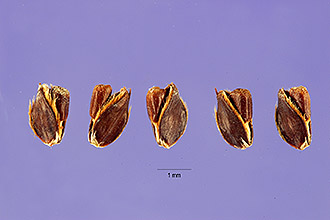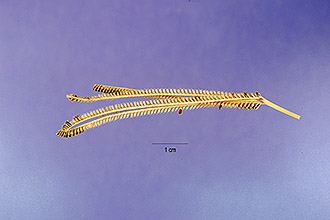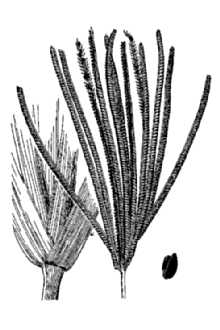Saltmarsh Fingergrass
Scientific Name: Eustachys glauca Chapm.

| General Information | |
|---|---|
| Usda Symbol | EUGL5 |
| Group | Monocot |
| Life Cycle | Perennial |
| Growth Habits | Graminoid |
| Native Locations | EUGL5 |
Plant Guide
Use a soil moisture meter to monitor the soil moisture where Saltmarsh Fingergrass is planted.
Fact Sheet
Alternate Name
Saltmarsh chloris, Chloris glauca
Uses
Saltmarsh fingergrass is grazed readily by cattle, horses, and sheep.
Status
Please consult the PLANTS Web site and your State Department of Natural Resources for this plant’s current status, such as, state noxious status and wetland indicator values.
Description
Grass Family (Poaceae). Saltmarsh fingergrass is a native, warm-season, perennial bunch grass. The height ranges from 3 to 4 feet. The leaf blade is folded 12 to 14 inches long, rounded at tip and dark green. The leaf sheath is crowded at the base, keeled, overlapping, and merges into the blade without a distinct collar. The ligule is a minute fringe of hairs. The seedhead has 15 to 20 spikes, each 4 to 5 inches long and the spikelets are brown, all on one side of rachis. From Hitchcock (1950) @ plants.usda.gov Distribution: For current distribution, please consult the Plant Profile page for this species on the PLANTS Web site.
Management
Continuous close grazing easily kills this grass. For maximum production and spread, graze it properly at all times and defer grazing every 2 to 3 years for at least 90 days throughout the growing season.
Establishment
Growth starts early in the spring and continues through the summer, It makes good regrowth, Growing points are 3 to 4 inches above ground early in the season, It produces seed two to three times during a long growing season, Use soil moisture sensors to measure the soil moisture of Saltmarsh Fingergrass., In southern Florida, parts of the plant stay green all year, It is adapted to coastal flatwoods, swamp margins, and sloughs on calcareous soils, thous it grows best in brackish marshes, Cultivars, Improved and Selected Materials (and area of origin) Please contact your local NRCS Field Office,


